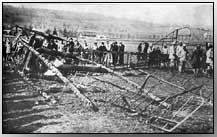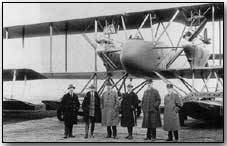The War in the Air - Bombers: Germany, Gotha and Giant
 During the last two weeks of 1914, before the first
Zeppelin
attack on Britain, there were a small number of abortive raids
against the Dover area by German seaplanes.
During the last two weeks of 1914, before the first
Zeppelin
attack on Britain, there were a small number of abortive raids
against the Dover area by German seaplanes.
A more successful bomber force of 36 airplanes was organized in the Bruges region, which carried out its first night raid, against Dunkirk, in January of 1915. This unit was planning to run raids against Britain, but before they could about half of them were transferred to the Eastern Front and provided tactical support to the German breakthrough at Gorlice-Tarnow.
The Germans then concentrated their bomber activities on the Zeppelin fleet, until by mid 1916 it was clear to all (excluding Strasser, the naval airship fleet commander) that the airships were not succeeding as expected.
In the autumn of 1916 the Germans began to equip with the Gotha twin engined bomber. Of a pusher layout, these aircraft could fly at 15,000 feet, above contemporary fighter's maximum height. With a range of 800 km (500 miles) and a bomb load of up to 500 kg (1,100 lb), the Gothas were designed to carry out attacks across the channel against Britain.
A group of four squadrons was established in Belgium, and they carried out their first bombing raid towards the end of May, 1917. This 22 plane sortie, against the town of Folkestone, caused 95 deaths. In mid June a force of 18 Gothas attacked London in broad daylight. They were met by over 90 British fighters, but not one Gotha was brought down. This bombing raid caused 162 deaths.
On the 7th of July 1917 over a hundred defensive sorties were flown against a 22 plane Gotha raid. In this case one Gotha was shot down, and three were damaged, at the cost of two fighters shot down by the Gotha's defensive gunners. It was only when the RFC began to equip their home defences with Sopwith Camels that the Gothas began to suffer serious losses and were forced to switch to night attacks.
From mid-September the Gothas were joined by an even larger, more potent bomber. The Zeppelin-Staaken Riesenflugzeug "Giant" bomber was a four engined tractor biplane with enclosed cabin that may have been inspired by the Russian Murometz. The Giant certainly deserved its title - its wing span of 42 metres (138 feet) was only one metre (3 feet) shorter than Boeing's famous B29 Superfortress of World War II fame, and its tailplane was roughly the same size as a Sopwith Pup.
It could carry a maximum bomb load of 2,000 kg (4,400lb) but for long range flights, such as against London, this was reduced to half that. It had a range of about 800km (500 miles). Like the Murometz, the engines could be serviced in mid-flight.
The Gotha/Giant night raids continued throughout 1917, almost unscathed, until December when the British began to have success in intercepting the Gothas at night. Anti-aircraft fire was also becoming more effective and increased use of barrage balloons affected the bombers.
 By
the end of the war a 50 mile long line of barrage balloons surrounded
London.
By
the end of the war a 50 mile long line of barrage balloons surrounded
London.
On the night of the 28th-29th of January 1918, after the loss of one Gotha over Britain and four more to crash landings back in Belgium, the Gotha squadrons were withdrawn for reorganization and training. When they became operational again in March they were employed primarily for tactical support during Germany's last great offensive on the Western Front.
In the meantime the Giants continued a small but influential campaign against London. On the 16th of February, during a four plane raid, a Giant dropped a 1,000 kg (2,200 lb) bomb - the largest used by anyone in the war - and blew up a wing of the Chelsea hospital.
During the same raid another Giant survived colliding with the cable of a barrage balloon and falling 1,000 feet before the pilot could regain control. The following evening a single Giant returned and scored a direct hit on St. Pancras station. The crew of this airplane reported that they saw anti-aircraft fire as far as twenty miles away - an indication of the psychological impact of attacks on urban targets.
The last raid of the war was carried out on the night of the 19th-20th of October 1918. This was a combined Gotha/Giant raid, and of the 38 Gothas taking part three were shot down by fighters and a further three were brought down by anti-aircraft fire.
No Giants were ever lost to British fighters or anti-aircraft guns, even though some were intercepted. A number were badly damaged by accidents during landing. The Giants were extremely complicated to build, and only 18 were ever completed.
The Germans hoped to cause widespread panic and even uprising with these raids. In this they failed, but the raids tied down a large number of aircraft, anti-aircraft guns and personnel that otherwise could have been used directly on the Western Front. The need for a coordinated air defence was one of the major reasons for the formation of the RAF in April of 1918.
One of the conditions of the armistice was that the German would hand over all their night bombers. When the British saw how few of these aircraft there actually were they initially suspected the Germans of hiding some of them.
The seeming invincibility of the bombers, especially in 1917, had a great influence on British military thinking well into the Second World War, for it was here that the British concept that "The heavy bomber will always get through" was born.
Article contributed by Ari Unikoski
Photographs courtesy of Photos of the Great War website
Next - Bombers - France
The financial cost of the war is said to have amounted to almost $38 billion for Germany alone; Britain spent $35 billion, France $24 billion, Russia $22 billion, USA $22 billion and Austria-Hungary $20 billion. In total the war cost the Allies around $125 billion; the Central Powers $60 billion.
- Did you know?
